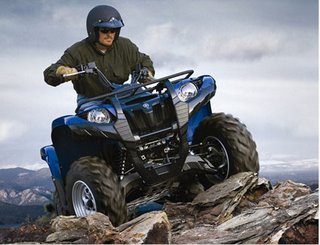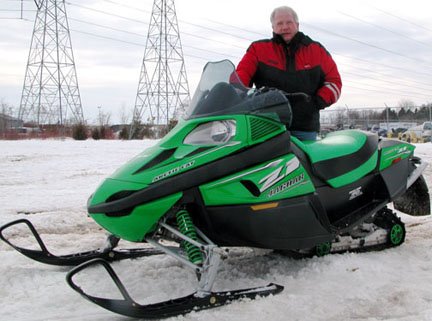 Jaguar Z1 Helps Push Cat’s Sled Sales to 9% Increase
Jaguar Z1 Helps Push Cat’s Sled Sales to 9% IncreaseThief River Falls, Minnesota-based Arctic Cat’s revenue went to $285 million from $276 million a year earlier. Arctic Cat expects that its full-year revenue growth will be in the range of 5% to 9% for snowmobiles; with a 3% to 5% increase in ATV sales; and, a year-end gain of up to 6% for parts, garments and accessories sales.
"Our record sales and increased earnings for the second quarter were driven primarily by a 9 percent increase in snowmobile sales, continued strong demand for our Prowler utility ATV, and higher ATV parts and accessories sales," said Christopher A. Twomey, chairman and chief executive officer. "We are confident that we remain on track to post sales gains across all of our product lines for the fiscal year."
Sales of Arctic Cat snowmobiles totaled $121.5 million in the 2007 second quarter, up 9 percent versus sales of $111.4 million in the same period last year. Contributing to the increase was the previously disclosed shift of Arctic Cat's extensive new model snowmobile production, and related revenue and earnings, into the company's fiscal 2007 second and third quarters. The company's year-to-date snowmobile sales totaled $142.4 million compared to $163.5 million in the prior-year period.
Arctic Cat continues to anticipate that its full-year snowmobile revenues will exceed last year based on strong dealer orders for its 2007 model line-up, of which 80 percent are new models.
Innovation Recognized: In recognition of its snowmobile innovation this year, three 2007 Arctic Cat sleds already have been named among the year's top sleds by a leading industry magazine. Snowmobiles chosen to receive this honor include Arctic Cat's Jaguar Z1, with the first 4-stroke engine built specifically for snowmobiles, the fast F8 Sno Pro, and the M1000 mountain sled with its leading power-to-weight ratio.
Year-to-date sales of Arctic Cat's ATVs grew 9 percent to $194.0 million versus $177.3 million in the first six months of last fiscal year.
Bio-Diesel ATV: During the second quarter, Arctic Cat also began shipping the industry's first twin cylinder diesel ATV with the introduction of its new Diesel 700 model.
"We are excited to begin shipping the first biodiesel-compatible ATV," said Twomey. "This machine reflects our stewardship goal to be a leader in fuel efficiency."
Arctic Cat's Diesel ATV, with its exceptional low-end torque, is ideally matched to Arctic Cat's line of SPEEDPoint accessories, making the machine highly versatile and allowing operators to change a variety of accessories in less than a minute.
The Prowler UTV continued to be a strong contributor to Arctic Cat's ATV business during the second quarter and first six months.
Parts, garments and accessories (PG&A) sales rose 3 percent continuing to benefit primarily from increased ATV parts and accessories sales.
Cat spokesmen noted that due to the timing of shipments, some snowmobile and ATV sales to dealers that were anticipated to occur in the second quarter will now occur in the third quarter.
The company said it expects to make 33 cents to 38 cents a share for the third quarter on revenue of $210 million to $230 million.
— ©2006 Snowmobilia/Jerry Bassett
 In the New York area as well — Bender Racing is now part of the DynoPort empire. Pipes, etc. will now come under the control of DynoPort’s Rich Daly who will maintain Bender Racing name for the foreseeable future. Good brand name. Although it would seem that former Bender Racing owner Terry Paine will retain turbocharger biz. He had been working on that side of the biz for quite a while with some very potent upgrades for 4stroke Yamahas. Keep an eye on these two New York-based sled suppliers for future products.
In the New York area as well — Bender Racing is now part of the DynoPort empire. Pipes, etc. will now come under the control of DynoPort’s Rich Daly who will maintain Bender Racing name for the foreseeable future. Good brand name. Although it would seem that former Bender Racing owner Terry Paine will retain turbocharger biz. He had been working on that side of the biz for quite a while with some very potent upgrades for 4stroke Yamahas. Keep an eye on these two New York-based sled suppliers for future products. Just when you think we’ve been developing hot new technology never seen before. Well, let’s just say that sometime long term memories are the best. For example, Polaris was playing around with V-configured engines nearly 40 years ago. Note the 1969 V4 800cc prototype at right in the photo. At left is an inline 4-cylinder motor displacing 1060cc that was built circa 1970. Haven’t things changed dramatically since then?
Just when you think we’ve been developing hot new technology never seen before. Well, let’s just say that sometime long term memories are the best. For example, Polaris was playing around with V-configured engines nearly 40 years ago. Note the 1969 V4 800cc prototype at right in the photo. At left is an inline 4-cylinder motor displacing 1060cc that was built circa 1970. Haven’t things changed dramatically since then?











